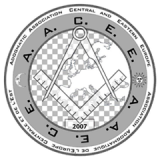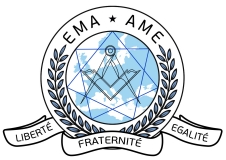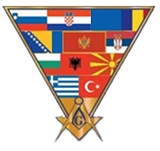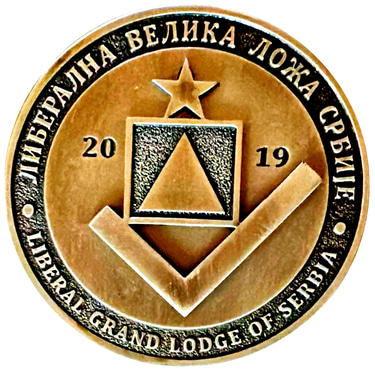Freemasonry in Serbia
In the second half of the eighteenth century, a big number of prominent Serbs who lived in Hungary and Croatia belonged to the Brotherhood of Freemasons. On the list of the "Magnanimitis" lodge in Buda, we find the names - Đorđe Milivojin - Orthodox archbishop of Pest, Pavle Davidović - an officer in the Austrian Army, and Stefan Vujanovski, a teacher. Archbishop Stefan Stratimirović of the Karlovac Diocese became a member of the Osijek Lodge "Vigilantia", even while he was the Abbot of Krušedol Monastery. Members of the same Lodge from 1783 were also Josif Jovanović Šakabenda - Bishop of Novi Sad and Stevan Novaković - People's Secretary.
According to some indications, Dositej Obradović, Vuk Karadžić, and Sima Milutinović-Sarajlija were Freemasons. However, the only thing that is known for sure about Sima Milutinović is that he was a member of the Brotherhood, elevated to the rank of Master in the "Minerva with Three Palms" Lodge in Leipzig.
From Sreten Stojković's book "Freemasonry - Letters to a Brother", published in Belgrade in 1893, we learn about the Masonic lodge in Belgrade at the end of the 18th century: "In what year was that Lodge in Belgrade founded, under what name, who was the Master, at what language was worked on and where the meetings were held, is unknown. But it is known that the members were: Belgrade Vizier Hadži - Mustafa Paša, Archbishop Metodije of Belgrade, Duke Janko Katić, Petar Ičko, the Čardaklija brothers, the Greek patriot Riga from Fera and others."
Austrian police documents from 1851 (from the state archives in Vienna) testify to us about the Masonic Lodge in Belgrade. From them, we learn that in June 1851 a certain Dr. Luis was sent to Belgrade, by order of the Austrian police. Luis, a professor at the Pest Industrial School and a freemason, investigates rumors about the existence of a Masonic Lodge in Belgrade as a spy, as well as to find out about its goals. From his report, supported by the additional report of the Austrian Consul in Belgrade at the time, we learn that the Lodge was called "Ali Koč" and that it had between 140 and 240 members - mostly Turks and Serbs, as well as a few Poles, French, and Germans. The Lodge had two Secretaries - one Turkish and one Christian. According to available historical materials, this Lodge was active between 1848 and 1862. Brother Sreten Stojković writes that the Ali Koč Lodge was ".. in that building between the first and second town gates, which housed the city infirmary, and whose facade is decorated with triangle and Egyptian columns at the entrance…” . Stojković further states that there is also written data about the Lodge. "Letters from 1848 tell us about the engagement of Ali Koč Lodge to stop the fight between Serbs and Hungarians. Later, this Lodge was moved from the city and until 1862 it was located in the town below the Main Police Station."
What remains unclear to this day is the origin of this Lodge in Belgrade - who founded it, what ritual works they used, and with which other Masonic Lodges in Europe or the Balkans they were related. All we know is that, among others, the members were: Toma Vučić-Perišić, Ahmed-Efendija-interpreter of the Belgrade Pasha, Captain Zah - director of the Serbian cavalry school, a rich Polish man under the pseudonym Moro, Professor Charles Aren - husband of the Czech woman Wilhelmina Wolf-Aren, the governess of the prince's children, the Polish count Tyskijewicz and Dushe - the president of the Polish committee. The Turk Ismail-Effendi is mentioned as a Master.
The first Masonic Lodge in Serbia, for which we have a confirmed "legal" Masonic origin, was founded in Belgrade in 1876, with the help of Italian freemasons, under the name "Light of the Balkans". This Lodge was officially founded under the patronage of the Grand Orient of Italy. The first Master of the Lodge was Dr. Marko Polak (doctor). The founding members of the Lodge were: Mihajlo Valtrović (university professor), Jozef Meisner (librarian of the National Library), Đorđe Milovanović (painter), Stevan Popović (university professor), Sveta Nikolajević (university professor), Đorđe Miličević (hotelier), Tasa Banković, Jovan Antula (merchants), William Bader (engineer), Ichilio Delabona, Albert Benedikt, Samuel and Jakob Levenzoni (merchants), Kornel Draškoci (pharmacist), Hajim Davičo and Manojlo Klidis (merchants). The first works of the Lodge were held in the building in Skadarska Street, and the Lodge soon moved to the premises of the Grand Hotel. The premises in the same building were used in the following years for the work of several newly formed Lodges.
In October 1881, the "Serbian Cooperative" Lodge began its work. Svetomir Nikolajević was elected Master. The founding members were: Mihajlo Vujić (university professor and later Minister in the Serbian Government), Steva Popović, Vasilije Popović, Pavle Mihajlović, Tasa Banković, Đorđe Milovanović and Maksa Antonijević. Most of these Brothers became Freemasons in the "Light of the Balkans" lodge.
In 1882, the Lodge "Light of the Balkans" ceased its work. Already the following year, the Lodge "Harmony, Work and Persistence" was founded, also under the protection of the Grand Orient of Italy. The founders of the lodge were former members of the closed Lodge "Light of the Balkans". Mihajlo Valtrović was elected as the first Master. Lodge "Srpska Zadruga" stopped working in 1885 and its members joined the Lodge "Sloga, Rad i Postojanstvo".
Political relations between Austria-Hungary and Serbia were suddenly worsened by the annexation of Bosnia and Herzegovina by Austria-Hungary in 1908. Serbian Masons from the "Pobratim" lodge, disappointed by the passivity of the Hungarian Brotherhood, their non-reaction in favor of the Serbian side and their refusal to condemn the act of the Austro-Hungarian Government, cut all ties with the Grand Lodge of Hungary and continue their work as an independent Lodge.
In 1909, the "Unification" Lodge began working in Belgrade under the patronage of the Grand Orient of France. In 1910, the Lodge "Sumadija" was founded under the auspices of the Grand Lodge of Hamburg.
In May 1911, the members of the "Pobratim" Lodge, headed by Worshipful Master Jovan Aleksijević, laid the foundation stone of the first Masonic Temple in Serbia, which was "brought to light" in April 1912 and the Temple began its work. The temple was built on the historic Vračar in Belgrade. The land for the Temple and the largest part of the financial resources for the construction of the Temple came from Đorđe Weifert. The architect was Brother Pavle Horstig, who provided his services for free. Interior decoration, windows, and furniture were provided through a generous donation from Brother Benjamin Fleischer. Additional funds for the maintenance of the Temple came through renting the Temple space to other Belgrade Lodges.
The year 1909 for Serbian Masons marks the beginning of work on the higher degrees of the Ancient and Accepted Scottish Order under the sponsorship of the Supreme Council of the Scottish Order of Romania,
Three years later (1912) with the Patent of the Supreme Council of the Ancient and Accepted Scottish Order of Greece, the Supreme Council of the Ancient and Accepted Scottish Rite of Serbia began its work. Brother J.S. Cefalas, as a special envoy of the Supreme Commander of the Supreme Council of Greece, awarded the honorary 33rd degree to Brothers: Svetomir Nikolajević, Milutin Perišić, Dimitrij Mijalković, Jovan Aleksijević, Dimitrij Janković, Petar Sreplović, Pavlo Horstig and Đorđe Weifert.
Brother Đorđe Weifert was elected Supreme Commander of the Supreme Council of the Ancient and Accepted Scottish Rite of Serbia. Lodge "Pobratim" immediately came under the protection of the Supreme Council of Serbia. Lodges "Šumadija" and Lodge "Harmony, Work and Persistence" returned the Patents they received from the Grand Lodge of Hamburg and the Grand Orient of Italy, and with their consent they came under the protection of the Supreme Council of Serbia. In the same year, at the Annual Assembly of the International Conference of the Supreme Council of the Ancient and Accepted Scottish Rite, in Washington (USA), the Supreme Council of Serbia was accepted as a regular, full member.
During the First World War, the work of the Supreme Council of Serbia was officially dormant. Unofficially, Đorđe Weifert, who was in exile in France with part of the Serbian government, manages to coordinate the work of Serbian freemasons from Marseille. The main focus of their activity is collecting humanitarian aid for the occupied and suffering Serbian people, as well as sending financial aid to the Masonic brothers who remained in their homeland.
After the end of the war, the Supreme Council of Serbia and the Belgrade Lodges continue their work in Serbia. At one of the first meetings, in February 1919 at the Grand Hotel, a decision was made to contact freemasons from Croatia with a proposal to establish a united Grand Lodge. Four months later, on June 9, 1919, the founding Assembly of the "Grand Lodge of Serbs, Croats and Slovenes - Yugoslavia" was held in Zagreb. Three Belgrade Lodges "Pobratim", Šumadija" and "Sloga, Rad i Postojanstvo" came under the protection of the Grand Lodge from Serbia; and from the Croatian lodge "Maksimalijan Vrhovec", "Ivan Grof Drašković", and "Budnost". Đorđe Wejfert from Belgrade was elected Grand Master, and Adolf Mihalić from Zagreb was elected Deputy Grand Master. The Supreme Council of the Ancient and Accepted Scottish Order of Serbia grows into the Supreme Council of the Ancient and Accepted Scottish Order of Serbs, Croats, and Slovenes.
In 1929, the Grand Lodge changed its name to the Grand Lodge of Yugoslavia. Twenty new Lodges were founded between the two world wars. With six founding Lodges and four annexed Lodges, the total number of Lodges under the protection of the Grand Lodge of Yugoslavia rose to thirty with over a thousand members. New Temples were opened, and the old ones, devastated during the First World War, were renovated and expanded. Very active in the humanitarian field, Serbian Freemasons are directly responsible for the establishment and financing of several humanitarian organizations: "Society for Orphans and Abandoned Children", Society "Sveti Sava", Society for Deaf Children "Kralj Dečanski", and "Disability Fund St. George". In the social and patriotic field, freemasons made a key contribution to the founding of the "National Defense" and the Chetnik Association.
On the international level, the Grand Lodge of Yugoslavia sponsored the establishment of the Grand Lodge of Czechoslovakia in 1923. Three years later, from September 11 to 16, 1926, the International Conference of Freemasons was held in Belgrade under the title "Manifestation of World Freemasonry in favor of Peace."
Social, religious, and political problems and conflicts in the Kingdom of Yugoslavia and in Europe, between the two world wars, influenced the work of freemasons. Although the Masons of Yugoslavia were mostly pro-Yugoslav oriented, there were also among them those who advocated the establishment of independent national Grand Lodges. Several Croatian Masons decide to go that way. This leads to the fact that in May 1927, four Lodges from Croatia founded the independent "Symbolic Grand Lodge Libertas".
With the strengthening of fascism in Italy and National Socialism in Germany at the beginning of the 1930s, there is a strengthening of anti-Masonic propaganda throughout Europe. One after another, the Grand Lodges in Italy, Germany, Portugal, Spain, Hungary and Austria cease to function. After the election of Anton Korošac, the leader of the Slovenian clerical party and an ardent opponent of Freemasonry, as Minister of Internal Affairs in the government of Milan Stojadinović (1935-1939), it became clear what fate awaited Freemasonry in Yugoslavia. At first, the authorities demanded that a police official be present at the work of the Lodge. After that, there was quiet pressure to force all Masons employed in government institutions to retire or resign. In May 1940, the Ministry of Internal Affairs issued an order prohibiting gatherings of citizens, and they especially pointed out that this order applied to gatherings of freemasons. This order was followed by searches of the premises of several Lodges in Belgrade and Zagreb and the confiscation of Masonic documents and property. Finally, on July 30, the Government decides to ban all Masonic activities on the territory of Yugoslavia. In this situation, the Administrative Council of the Grand Lodge of Yugoslavia decided on August 1, 1940, to suspend the work of all Lodges under their protection and to "put the Grand Lodge to sleep".
The beginning of the Second World War, the collapse of the Kingdom of Yugoslavia, and the German occupation led to an even fiercer persecution of Freemasons in Serbia. The Gestapo seizes the documentation of the Grand Lodge and arrests prominent Freemasons.
According to some data, almost 200 Freemasons were sent to prison. In October 1941, an anti-Masonic exhibition was opened in Belgrade, the aim of which was to "disclose and expose" the alleged "conspiracy of communists, Jews and freemasons against Serbs and peace in the world". The Serbian Post, by order of the Quisling government, marked this event by issuing a series of four postage stamps with anti-Masonic messages. They are so far the only anti-Masonic stamps ever printed in the world.
After the end of the war, the work of freemasons and their lodges was prohibited by law in the new (communist) Yugoslavia. Despite the ban, at the beginning of the 1950s, informal Masonic groups were formed, which police agents named in their reports the "Belgrade Lodge" and the "Jugoslovenska Lodge". the group is called "enemies of the socialist system and anti-communists".
Although their lodges were dormant as early as 1940, the Masons who remained in the country maintained strong mutual relations and helped each other. This mutual fraternal support was particularly felt at the University of Belgrade and at the Serbian Academy of Sciences and Arts, where a significant number of pre-war professors and academics belonged to the Brotherhood of Freemasons.
The fall of the Berlin Wall marks the beginning of the revival of Freemasonry in Eastern Europe. Hungary was the first Eastern European country to "awaken" the Grand Lodge. It was followed by Yugoslavia. In April 1990, the Lodges "Pobratim", Sloga, Rad i Postojanstvo" and "Maksimilijan Vrhovec" were officially registered with the state authorities in Belgrade. Two months later, representatives of the United Grand Lodge of Germany brought light and reactivated the Grand Lodge of Yugoslavia at a ceremony in Belgrade. After the breakup of Yugoslavia in 1991, the Grand Lodge changed its name to the Grand Lodge "Yugoslavia".
Zoran Nenezić, a journalist and writer from Belgrade, was appointed as the first Grand Master. Within three years this Grand Lodge was recognized by all the most important jurisdictions in the world. However, the unstable political situation in the country affected the work of the members in the Lodges, which led to conflicts and divisions within the Grand Lodge. A group of Grand Lodge members decided in 1993 at a meeting in Rimini (Italy) to elect a new Grand Master and change the name to Regular Grand Lodge "Yugoslavia". The Regular Grand Lodge "Yugoslavia" was registered under that name with the competent authorities and soon after it was recognized by the United Grand Lodge of Germany, the United Grand Lodge of England, the Grand Lodge of New York, and all significant "regular" Jurisdictions in the world as the only legal and regular Masonic Jurisdiction in Yugoslavia (Serbia and Montenegro).
Zoran Nenezić and the group of Masons who supported him did not recognize this course of events and continued their activities under the old name - Grand Lodge "Yugoslavia". This group, of course, was no longer recognized by any regular Jurisdiction in the world. After four years of work as an unrecognized Jurisdiction, a group of about a hundred members separated from the Grand Lodge of Yugoslavia and formed the National Grand Lodge of Yugoslavia under which name they registered with the authorities in Belgrade. Shortly after its foundation, this Jurisdiction was recognized by two French Jurisdictions: the Grand Lodge of France and the Traditional and Symbolic Grand Lodge of the "Opera."
In 2006, the Regular Grand Lodge of Yugoslavia already had twenty-two Lodges in Serbia and Montenegro. In the same year, RVLJ changed its name to the Regular Grand Lodge of Serbia (RVLS). A decision was also made to separate three Lodges from the territory of Montenegro for the purpose of creating the Grand Lodge of Montenegro in 2007. In the same year 2006, new disagreements and turbulence occurred in Serbian Freemasonry. As a consequence of these conflicts, three Lodges from the Regular Grand Lodge of Serbia withdrew from this jurisdiction and together with the regularized Brethren of two Lodges from the National Grand Lodge and a certain number of Brethren from the Grand Lodge of Yugoslavia established the United Grand Lodge of Serbia (UVLS). Until 2018, this Jurisdiction was second in terms of number of members and activities, right after the Regular Grand Lodge of Serbia. In 2008, the UVLS built the first Masonic Temple in Belgrade after the Second World War. Two years later, they founded the first specialized Masonic library in the Temple premises. The idea behind the creation of this Grand Lodge was the unification of all Serbian Freemasons in one Jurisdiction. Despite several years of efforts, as well as the help provided in this regard by the United Grand Lodge of Germany and the Grand Lodge of Austria, this idea was never realized.
The Grand Orient of France, as the main representative of liberal Freemasonry, and other liberal female and co-Masonic (mixed) European Jurisdictions, did not remain passive in the penetration towards the reopened democracies of Eastern Europe. In 1992, several candidates from Belgrade were initiated in Paris. Soon, as soon as the conditions were met, the Lodge "Zora" was founded in Belgrade under the protection of the Grand Orient of France. Light was introduced into the second Belgrade Lodge "Vernost" in 2002. In May 2006, light was introduced into the third Lodge of the Grand Orient of France in Belgrade. This Lodge was named "Unification" with the idea of continuing the tradition of the first Lodge of the same name of the Grand Orient of France founded in Belgrade in 1909. By 2023, the Grand Orient of France had established 14 Lodges in Serbia that are still working under the protection of the GOdF.
Women's Freemasonry is also active in Serbia. Under the protection of the Women's Grand Lodge of France, the Belgrade "triangle" under the name "Rose of the Winds" was founded in 1994. The increase in the number of members of the triangle enabled the establishment of the first female Masonic Lodge in Belgrade under the name "Vera Fides" in 2007. Over the years, three more lodges were founded - "Danica," "Aurora," and "Naisa," and in 2022, under the sponsorship of the Women's Grand Lodge of France, the Women's Grand Lodge of Serbia was founded.
Mixed Masonry, which exists as an international co-masonic organization under the name "Human Rights" (Droit Humaine), is also present in Serbia. In 2009, Workshop "Singidunum- East" No. 1899 was established in Belgrade as part of MMMR "Human Rights" and is the first Mixed Workshop of that Order on Serbian soil.
In 2018, six lodges from the list of the United Grand Lodges of Serbia jointly decided to turn to the practice of liberal freemasonry, seeing that form of freemasonry as a more appropriate concept of Freemasonry, which was more in line with the aspirations and ideals of the members of these Lodges. They turned to liberal obediences in the region for help, which resulted in the creation of the first liberal masonic obedience in Serbia. In March 2020, in Belgrade, the Grand Orient of Austria, the Grand Orient of Romania, and the Grand Orient of Slovenia, in the presence of guests from several other European liberal jurisdictions, brought light and jointly issued a Patent for the establishment of the Liberal Grand Lodge of Serbia. Recognized by a large number of liberal Masonic jurisdictions in Europe and the world, LGLS is a full member of several international Masonic organizations such as the Adogmatic Masonic Association of Central and Eastern Europe (AACEE), the Masonic Association of the Balkans (MUB) C.L.I.P.S.A.S. (Le Center de Liaison et d'Information des Puissances maçonniques Signataires de l'Appel de Strasbourg) and others.
Freemasonry "awakened" again and continued its work in Serbia more than thirty years ago. After many divisions, turbulence, and searches, today it is a picture of a mature Masonic community with a clear division into two groups: one dogmatic - with the Regular Grand Lodge of Serbia, recognized by a large number of so-called "regular" jurisdictions around the world, the Grand National Lodge of Serbia, recognized from several Grand Lodges from Europe and the world, and several smaller unrecognized groups under different names; and the other liberal - with the Liberal Grand Lodge of Serbia, recognized by a large number of liberal jurisdictions around the world, the Women's Grand Lodge of Serbia, also recognized by a large number of liberal jurisdictions around the world, 14 lodges of the Grand Orient of France, and the workshop of the "Human Rights" Organization. Formally, according to the available data, there are over 100 masonic lodges in different jurisdictions in Serbia today, with an informal membership estimate of around 2,500 freemasons.

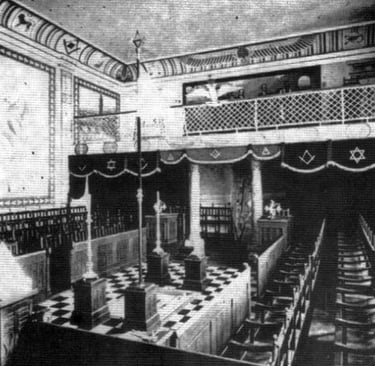


The first Masonic Temple erected in Belgrade in 1912
Two famous Serbian Masons in conversation: Nikola Tesla and King Peter the Second
Connect
office@lvls.org.rs
Liberal Grand Lodge of Serbia - All rights reserved 2023
Subscribe to our newsletter
sekretarijat@lvls.org.rs


